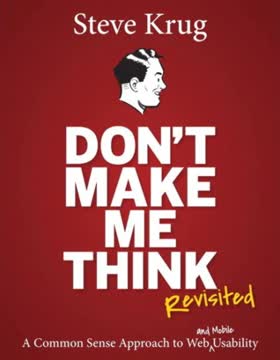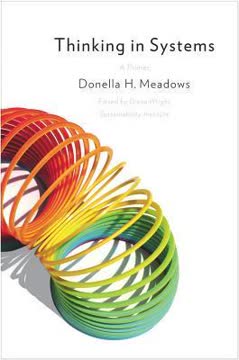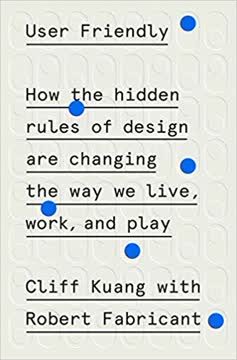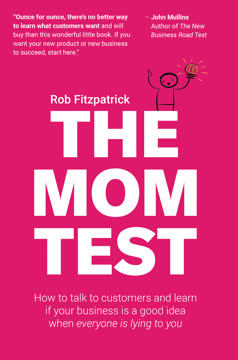Key Takeaways
1. Writing is designing: Words shape user experiences
Words build digital experiences, and this book is all about creating good experiences for the people who use software on their computers, phones, watches, and other devices.
Words as design elements. In digital interfaces, words are not just content; they are integral design components. Every button label, menu item, and error message contributes to the overall user experience. UX writers play a crucial role in shaping how users interact with and perceive products.
Beyond button labels. UX writing extends far beyond crafting catchy taglines or filling in text boxes. It involves:
- Designing the entire user journey through words
- Collaborating with designers, developers, and product managers
- Solving complex problems through clear, concise language
- Creating a cohesive product voice that aligns with business goals
UX writers must think like designers, considering user needs, business objectives, and technical constraints when crafting content. This approach ensures that words not only convey information but also guide users effectively through digital experiences.
2. Strategy and research are foundational to effective UX writing
Before you start writing, start designing.
User-centered approach. Effective UX writing begins with a deep understanding of users and their needs. This requires a strategic approach that incorporates research methods such as:
- User interviews
- Contextual inquiry
- Usability testing
- Analytics analysis
Data-driven decisions. By gathering insights about user behavior, preferences, and pain points, UX writers can make informed decisions about language, tone, and content structure. This research-based approach helps to:
- Align writing with user expectations
- Identify opportunities for improvement
- Validate assumptions about user needs
- Create more effective and engaging interfaces
Strategy development involves collaboration with stakeholders to define goals, create user personas, and establish key performance indicators (KPIs) for the writing. This foundational work ensures that UX writing supports both user needs and business objectives.
3. Clarity is paramount in interface design and content
If, as the writer, I have to think about the words for more than two seconds, I know it's not good copy.
Simplicity and directness. Clear writing is essential for creating intuitive user experiences. UX writers should strive to:
- Use plain language that users can easily understand
- Avoid jargon and technical terms unless necessary
- Break complex ideas into digestible chunks
- Prioritize user goals over clever or witty phrasing
Cognitive load reduction. By focusing on clarity, UX writers help reduce the mental effort required for users to navigate interfaces. This involves:
- Using familiar terms and metaphors
- Providing context and explanations when needed
- Structuring information logically and consistently
- Anticipating user questions and addressing them proactively
Clear writing not only improves usability but also builds trust with users by demonstrating that the product respects their time and attention. UX writers should constantly ask themselves if their content is serving users' needs or creating unnecessary obstacles.
4. Error messages and stress cases require thoughtful design
Showing solutions is what ultimately builds trust with your users. When you fail to explain what's going wrong, it can mean the difference between a user embracing or rejecting your product.
Empathy in error handling. Error messages are critical touchpoints that can make or break the user experience. UX writers should approach error messages with empathy, considering the user's emotional state and needs. Key principles include:
- Avoiding blame or technical jargon
- Clearly explaining what went wrong
- Providing actionable steps to resolve the issue
- Maintaining a supportive and reassuring tone
Designing for stress cases. UX writers must consider extreme scenarios and edge cases when crafting content. This involves:
- Anticipating potential user frustrations
- Addressing accessibility concerns
- Considering cultural and linguistic differences
- Designing for users in high-stress situations
By thoughtfully designing error messages and accounting for stress cases, UX writers can turn potentially negative experiences into opportunities to build trust and demonstrate the product's value to users.
5. Inclusive and accessible writing benefits all users
Inclusive experiences benefit everyone.
Universal design principles. Inclusive writing aims to create content that is accessible and meaningful to the widest possible audience. This involves:
- Using gender-neutral language
- Avoiding cultural assumptions and stereotypes
- Considering diverse reading levels and cognitive abilities
- Providing alternative text for images and multimedia content
Accessibility as a priority. UX writers play a crucial role in ensuring digital products are accessible to users with disabilities. Key considerations include:
- Writing clear and descriptive link text
- Structuring content with proper headings and landmarks
- Avoiding reliance on color alone to convey meaning
- Providing text alternatives for non-text content
By prioritizing inclusivity and accessibility, UX writers not only comply with legal requirements but also create better experiences for all users, regardless of their abilities or backgrounds.
6. Voice and tone establish product identity and guide user interactions
Voice is the personality that your brand, or product, or digital interface manifests, which sets it apart from others. Tone is the way that voice is expressed in certain contexts, i.e., to respond to or guide a user through a particular workflow or interaction.
Defining voice. A product's voice is its consistent personality expressed through words. UX writers should work with stakeholders to develop voice guidelines that:
- Align with the brand's values and mission
- Differentiate the product from competitors
- Resonate with the target audience
- Remain consistent across various touchpoints
Adapting tone. While voice remains constant, tone should adapt to different user contexts and emotional states. UX writers should develop a tone framework that considers:
- User goals and motivations
- Emotional states (e.g., frustrated, excited, confused)
- Interaction types (e.g., onboarding, error messages, confirmations)
- Platform constraints (e.g., mobile vs. desktop)
By establishing a clear voice and flexible tone, UX writers create a cohesive and empathetic user experience that builds trust and engagement with the product.
7. Collaboration and consistency are key to successful UX writing
Everyone on the team is working together to design the experience.
Cross-functional teamwork. UX writing is not a solitary activity but requires close collaboration with designers, developers, product managers, and other stakeholders. Effective collaboration involves:
- Participating in early design discussions
- Sharing research insights and user feedback
- Advocating for user needs throughout the development process
- Facilitating workshops and critiques to align on content strategy
Maintaining consistency. As products evolve and teams grow, maintaining consistency in UX writing becomes increasingly challenging. Tools and processes to ensure consistency include:
- Style guides and content standards
- Design systems that incorporate UX writing guidelines
- Regular content audits and reviews
- Shared repositories of approved content patterns
By fostering collaboration and establishing systems for consistency, UX writers can ensure that their work is integrated seamlessly into the product development process and contributes to a cohesive user experience across all touchpoints.
Last updated:
FAQ
What is "Writing Is Designing: Words and the User Experience" by Michael J. Metts and Andy Welfle about?
- Core Thesis: The book argues that writing for digital products is a design practice, not just an afterthought, and that words are central to shaping user experiences.
- Role of Writers: It positions writers as designers who should be involved throughout the product development process, collaborating with teams to create usable, useful, and responsible interfaces.
- Practical Guidance: The book provides frameworks, strategies, and real-world examples for integrating writing into UX design, covering everything from error messages to inclusivity.
- Audience: It’s written for anyone who writes for users—UX writers, designers, product managers, developers, and content strategists.
Why should I read "Writing Is Designing" by Michael J. Metts and Andy Welfle?
- Elevate Your Writing: The book helps you see how words can be used strategically to improve digital products, making your writing more impactful.
- Collaboration Focus: It offers practical advice on working with cross-functional teams, ensuring your writing is valued and integrated into the design process.
- User-Centered Approach: You'll learn how to research, test, and iterate on your words to better meet user needs and business goals.
- Inclusivity and Accessibility: The book emphasizes the importance of inclusive and accessible language, making your products better for everyone.
What are the key takeaways from "Writing Is Designing" by Michael J. Metts and Andy Welfle?
- Writing is Design: Treat every word in an interface as a design decision that shapes user experience.
- Strategy and Research Matter: Effective writing starts with understanding users, aligning on strategy, and conducting research—not just filling in text.
- Clarity, Usability, and Responsibility: Strive for clear, usable, and responsible language that helps users accomplish their goals and avoids harm.
- Collaboration is Essential: Writers should work closely with designers, developers, and stakeholders to ensure consistency and quality across products.
Who should read "Writing Is Designing" by Michael J. Metts and Andy Welfle?
- UX Writers and Content Strategists: Anyone responsible for the words users see and interact with in digital products.
- Designers and Developers: Those who occasionally write interface copy or want to better understand the role of language in UX.
- Product Managers and Leaders: People who manage or collaborate with writers and want to integrate writing into the design process.
- Anyone Interested in UX: The book is accessible to those new to UX writing as well as experienced professionals seeking to deepen their practice.
How does "Writing Is Designing" by Michael J. Metts and Andy Welfle define the relationship between writing and design?
- Words as Design Material: The book asserts that words are as fundamental to design as visuals, interactions, and code.
- Iterative and Collaborative: Writing should be developed iteratively, validated with research, and created in collaboration with the broader product team.
- Problem-Solving Focus: Writing is not just about fitting words into spaces but about solving user problems and shaping experiences.
- Design Mindset: Writers should adopt a design mindset, asking not just how to phrase something, but what users need and how language can help.
What is the process for creating effective UX writing according to "Writing Is Designing"?
- Start with Strategy: Align on product and content strategy before writing, ensuring everyone is on the same page about goals and user needs.
- Conduct Research: Use user interviews, contextual inquiry, and usability testing to understand how users talk and what they need.
- Test and Iterate: Validate your words with real users, using methods like content testing and follow-up questions to refine messages.
- Collaborate and Document: Work closely with your team, document decisions, and create guidelines to maintain consistency.
How does "Writing Is Designing" by Michael J. Metts and Andy Welfle approach error messages and stress cases?
- Reframe Errors as Opportunities: View error states as chances to help users, not just deliver bad news.
- Avoid, Explain, Resolve: Strive to prevent errors, clearly explain what went wrong, and provide actionable solutions.
- Empathy and Responsibility: Avoid blaming users; instead, take responsibility and design messages that support and guide users through problems.
- Test with Real Users: Regularly test error messages to ensure they are clear, helpful, and reduce user frustration.
What guidance does "Writing Is Designing" offer on inclusivity and accessibility in UX writing?
- Inclusive Language: Use language that welcomes all users, avoiding assumptions about gender, ability, or background.
- Accessibility Standards: Follow guidelines like WCAG2 to ensure content is perceivable, operable, understandable, and robust for all users.
- Practical Tips: Write chronologically (not spatially), avoid relying solely on color or icons, and use device-agnostic action words.
- Continuous Learning: Recognize that inclusive language evolves; stay updated and be open to feedback and correction.
What is the difference between "voice" and "tone" in UX writing, as explained in "Writing Is Designing"?
- Voice is Consistent Personality: Voice is the set of constant attributes that define your product’s personality and how it communicates.
- Tone is Contextual Expression: Tone shifts depending on the situation, user state, or context—adapting the voice to meet users where they are.
- Developing Both: The book provides strategies for defining voice principles and creating tone profiles to ensure consistency and appropriateness.
- Practical Examples: Real-world examples show how voice and tone work together to create engaging, effective, and empathetic user experiences.
How does "Writing Is Designing" by Michael J. Metts and Andy Welfle recommend collaborating and maintaining consistency across teams?
- Build Relationships: Develop empathy with your team, understand their needs, and contribute where you can to build trust.
- Facilitate Understanding: Use workshops, canvases, and shared documents to align on problems, objectives, and solutions.
- Show Your Work: Visualize writing decisions with maps, flows, and interface mockups to make your work accessible and understandable.
- Create and Use Guidelines: Develop style guides, design systems, and reusable patterns to ensure consistency and efficiency across products.
What are some of the most important methods and frameworks introduced in "Writing Is Designing" by Michael J. Metts and Andy Welfle?
- Strategy Statements: Use collaborative exercises (like Mad Libs) to align teams on user needs, business goals, and product value.
- Content Testing: Remove words from interfaces and test them in isolation to gauge user confidence and understanding.
- Voice and Tone Frameworks: Document voice attributes and tone profiles to guide writing decisions and adapt to different contexts.
- Design Systems Integration: Incorporate writing into design systems, ensuring words are treated as reusable, strategic components.
What are the best quotes from "Writing Is Designing" by Michael J. Metts and Andy Welfle, and what do they mean?
- "Writing is designing." – The central thesis: every word in a product shapes the user experience and should be treated as a design decision.
- "Do the hard work to make it simple." – Emphasizes the effort required to create clear, accessible, and user-friendly language.
- "If the words you write for something aren’t accessible to everyone, then you’ve made a design choice that prevents people from using that thing." – Highlights the ethical responsibility of writers to ensure inclusivity and accessibility.
- "Stop writing clever copy. Start writing to design." – Encourages writers to prioritize user needs and clarity over wit or marketing flair.
Review Summary
Writing Is Designing receives overwhelmingly positive reviews, with readers praising its practical advice, clear examples, and accessible style. Many find it valuable for both beginners and experienced professionals in UX writing and content strategy. Reviewers appreciate the book's focus on collaboration, inclusivity, and user-centered design. It's commended for its insights on voice, tone, and the strategic importance of writing in product development. Some readers note that while it's an excellent introduction, advanced practitioners may find it less groundbreaking. Overall, it's highly recommended for anyone involved in crafting user experiences.
Similar Books









Download PDF
Download EPUB
.epub digital book format is ideal for reading ebooks on phones, tablets, and e-readers.




